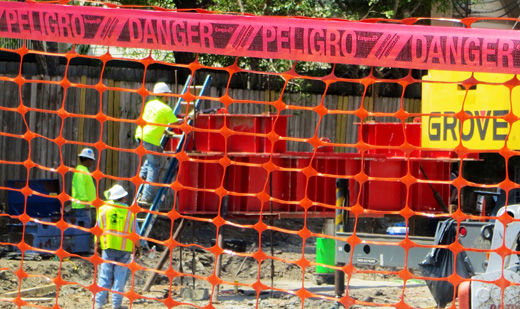
Around Halloween in 2012, Jamie Hoyt reported for work, hired by Labor Ready, to a Verizon plant in Pearl River, N.J. The sunny, optimistic 58-year-old – as his sister describes him — never came home.
Verizon engaged temp services company Labor Ready, which hired Hoyt. It turned him and responsibility for his job over to a subcontractor who in turn turned him and other workers over to the driver of an 18-wheel tractor trailer.
The workers’ task was to load 2,500 pounds of computer equipment – servers – from the loading dock at the Pearl River plant onto the tractor-trailer for transportation elsewhere. But the truck was too big for the Pearl River loading dock, so its driver hired a smaller truck to transfer pallets of servers from there to the big truck, using the rear flaps of both vehicles.
What happened next to her brother the temp, says Mary Jo Hoyt, a registered nurse, was a preventable death. With no protection, no safeguards, no training and no support for the two trucks’ rear flaps, the third pallet of servers slipped. It fell right on top of her brother.
Mary Jo Hoyt said she got a call from Pearl River that Jamie was taken to a nearby emergency room. When she called there, she heard, “The situation is very grave and the family should come immediately.” “As a nurse, I knew what those words meant,” she said.
Meanwhile, Verizon profited, by hiring Labor Ready, which hired Jamie, and which hired the other firm, that hired the driver. Her brother died.
Though he died four years ago, Jamie Hoyt is an example of a class of workers increasingly at risk of death on the job: Temps. And a new report from the National Council on Occupational Safety and Health says most of those deaths, like his, were preventable.
Hoyt detailed her brother’s death in a telephone press conference to reveal the report, issued in time for Workers Memorial Day, April 28. Federal job safety, health and death statistics showed 802 temporary workers died on the job in 2014, up from 542 in 2011, the first year temps’ deaths were separately reported. The 2014 data is the latest available, and the 802 temps were one of every six workers who died on the job that year.
“Contract workers are most frequently assigned to the most hazardous jobs,” says Jessica Martinez, acting executive director of the National Council on Occupational Safety and Health. “And in too many cases, employers are not meeting their legal obligations to provide safe working conditions” or training workers in safety practices, she adds.
Besides spotlighting the hazards to temps, the council’s report, Preventable Deaths, notes that many job-related deaths occur long after the worker has left the job. “Cancer claims more lives than any other occupational disease in most countries,” it says. “The disease can be prevented, writes safety engineer Jukka Takala, president of the International Commission on Occupational Health, ‘by reducing or eliminating the exposures leading to the disease.'”
Photo: Jan Carson/Flickr (CC)









